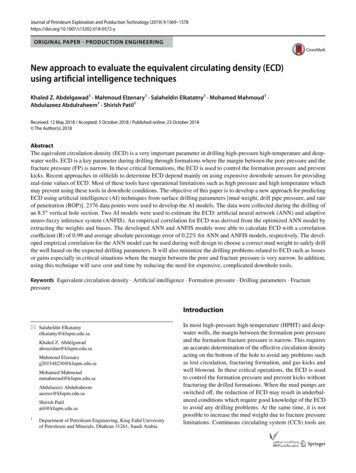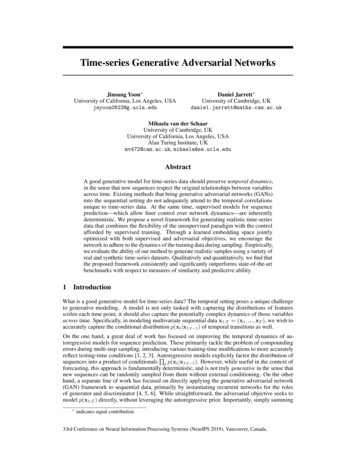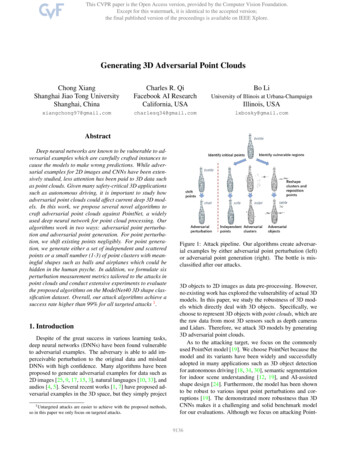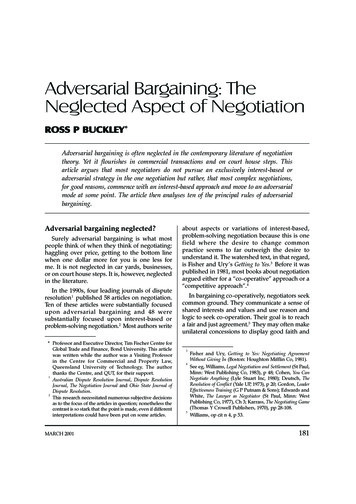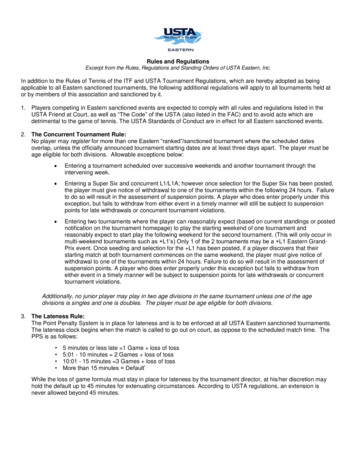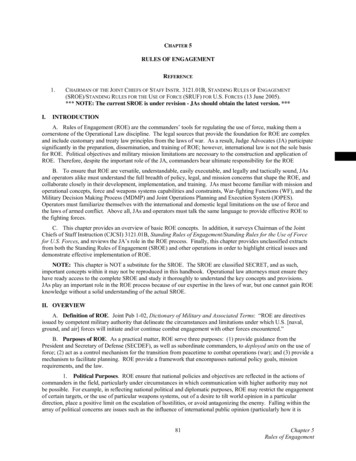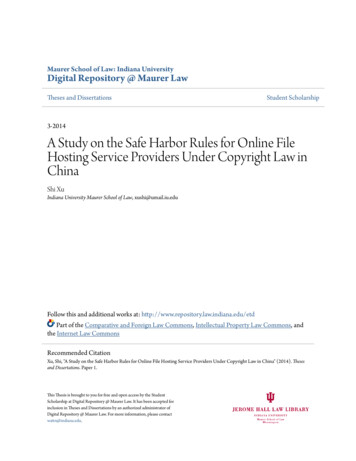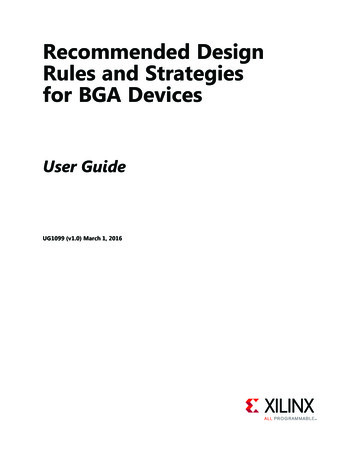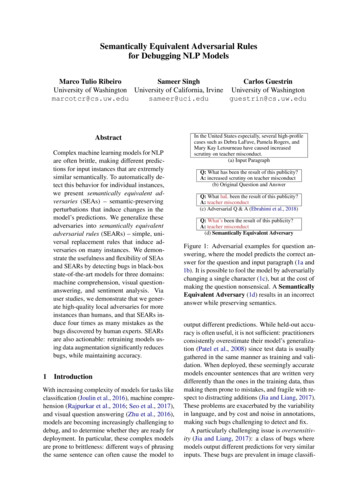
Transcription
Semantically Equivalent Adversarial Rulesfor Debugging NLP ModelsMarco Tulio RibeiroSameer SinghCarlos GuestrinUniversity of Washington University of California, Irvine University of @cs.uw.eduAbstractComplex machine learning models for NLPare often brittle, making different predictions for input instances that are extremelysimilar semantically. To automatically detect this behavior for individual instances,we present semantically equivalent adversaries (SEAs) – semantic-preservingperturbations that induce changes in themodel’s predictions. We generalize theseadversaries into semantically equivalentadversarial rules (SEARs) – simple, universal replacement rules that induce adversaries on many instances. We demonstrate the usefulness and flexibility of SEAsand SEARs by detecting bugs in black-boxstate-of-the-art models for three domains:machine comprehension, visual questionanswering, and sentiment analysis. Viauser studies, we demonstrate that we generate high-quality local adversaries for moreinstances than humans, and that SEARs induce four times as many mistakes as thebugs discovered by human experts. SEARsare also actionable: retraining models using data augmentation significantly reducesbugs, while maintaining accuracy.1IntroductionWith increasing complexity of models for tasks likeclassification (Joulin et al., 2016), machine comprehension (Rajpurkar et al., 2016; Seo et al., 2017),and visual question answering (Zhu et al., 2016),models are becoming increasingly challenging todebug, and to determine whether they are ready fordeployment. In particular, these complex modelsare prone to brittleness: different ways of phrasingthe same sentence can often cause the model toIn the United States especially, several high-profilecases such as Debra LaFave, Pamela Rogers, andMary Kay Letourneau have caused increasedscrutiny on teacher misconduct.(a) Input ParagraphQ: What has been the result of this publicity?A: increased scrutiny on teacher misconduct(b) Original Question and AnswerQ: What haL been the result of this publicity?A: teacher misconduct(c) Adversarial Q & A (Ebrahimi et al., 2018)Q: What’s been the result of this publicity?A: teacher misconduct(d) Semantically Equivalent AdversaryFigure 1: Adversarial examples for question answering, where the model predicts the correct answer for the question and input paragraph (1a and1b). It is possible to fool the model by adversariallychanging a single character (1c), but at the cost ofmaking the question nonsensical. A SemanticallyEquivalent Adversary (1d) results in an incorrectanswer while preserving semantics.output different predictions. While held-out accuracy is often useful, it is not sufficient: practitionersconsistently overestimate their model’s generalization (Patel et al., 2008) since test data is usuallygathered in the same manner as training and validation. When deployed, these seemingly accuratemodels encounter sentences that are written verydifferently than the ones in the training data, thusmaking them prone to mistakes, and fragile with respect to distracting additions (Jia and Liang, 2017).These problems are exacerbated by the variabilityin language, and by cost and noise in annotations,making such bugs challenging to detect and fix.A particularly challenging issue is oversensitivity (Jia and Liang, 2017): a class of bugs wheremodels output different predictions for very similarinputs. These bugs are prevalent in image classifi-
Transformation Rules(WP is WP’s)(? ?)#Flips70 (1%)202(3%)(a) Example RulesOriginal: What is the oncorhynchusalso called? A: chum salmonChanged: What’s the oncorhynchusalso called? A: ketaOriginal: How long is the Rhine?A: 1,230 kmChanged: How long is the Rhine?A: more than 1,050,000(b) Example for (WP is WP’s)(c) Example for (? ?)Figure 2: Semantically Equivalent Adversarial Rules: For the task of question answering, the proposedapproach identifies transformation rules for questions in (a) that result in paraphrases of the queries, butlead to incorrect answers (#Flips is the number of times this happens in the validation data). We showexamples of rephrased questions that result in incorrect answers for the two rules in (b) and (c).cation (Szegedy et al., 2014), a domain where onecan measure the magnitude of perturbations, andmany small-magnitude changes are imperceptibleto the human eye. For text, however, a single wordaddition can change semantics (e.g. adding “not”),or have no semantic impact for the task at hand.Inspired by adversarial examples for images,we introduce semantically equivalent adversaries (SEAs) – text inputs that are perturbed insemantics-preserving ways, but induce changes ina black box model’s predictions (example in Figure1). Producing such adversarial examples systematically can significantly aid in debugging ML models,as it allows users to detect problems that happenin the real world, instead of oversensitivity onlyto malicious attacks such as intentionally scrambling, misspelling, or removing words (Bansalet al., 2014; Ebrahimi et al., 2018; Li et al., 2016).While SEAs describe local brittleness (i.e. arespecific to particular predictions), we are also interested in bugs that affect the model more globally.We represent these via simple replacement rulesthat induce SEAs on multiple predictions, such asin Figure 2, where a simple contraction of “is”afterWh pronouns (what, who, whom) (2b) makes 70(1%) of the previously correct predictions of themodel “flip” (i.e. become incorrect). Perhaps moresurprisingly, adding a simple “?” induces mistakesin 3% of examples. We call such rules semanticallyequivalent adversarial rules (SEARs).In this paper, we present SEAs and SEARs, designed to unveil local and global oversensitivitybugs in NLP models. We first present an approachto generate semantically equivalent adversaries,based on paraphrase generation techniques (Lapataet al., 2017), that is model-agnostic (i.e. works forany black box model). Next, we generalize SEAsinto semantically equivalent rules, and outline theproperties for optimal rule sets: semantic equivalence, high adversary count, and non-redundancy.We frame the problem of finding such a set as asubmodular optimization problem, leading to anaccurate yet efficient algorithm.Including the human into the loop, we demonstrate via user studies that SEARs help users uncover important bugs on a variety of state-of-the-artmodels for different tasks (sentiment classification,visual question answering). Our experiments indicate that SEAs and SEARs make humans significantly better at detecting impactful bugs – SEARsuncover bugs that cause 3 to 4 times more mistakesthan human-generated rules, in much less time. Finally, we show that SEARs are actionable, enablingthe human to close the loop by fixing the discovered bugs using a data augmentation procedure.2Semantically Equivalent AdversariesConsider a black box model f that takes a sentencex and makes a prediction f (x), which we wantto debug. We identify adversaries by generatingparaphrases of x, and getting predictions from funtil the original prediction is changed.Given an indicator function SemEq(x, x0 ) thatis 1 if x is semantically equivalent to x0 and 0 otherwise, we define a semantically equivalent adversary (SEA) as a semantically equivalent instancethat changes the model prediction in Eq (1). Suchadversaries are important in evaluating the robustness of f , as each is an undesirable bug. 000SEA(x, x ) 1 SemEq(x, x ) f (x) 6 f (x ) (1)While there are various ways of scoring semanticsimilarity between pairs of texts based on embeddings (Le and Mikolov, 2014; Wieting and Gimpel,2017), they do not explicitly penalize unnatural sentences, and generating sentences requires surrounding context (Le and Mikolov, 2014) or traininga separate model. We turn instead to paraphrasing based on neural machine translation (Lapataet al., 2017), where P (x0 x) (the probability of aparaphrase x0 given original sentence x) is proportional to translating x into multiple pivot languages
and then taking the score of back-translating thetranslations into the original language. This approach scores semantics and “plausibility” simultaneously (as translation models have “built in” language models) and allows for easy paraphrase generation, by linearly combining the paths of eachback-decoder when back-translating.Unfortunately, given source sentences x and z,P (x0 x) is not comparable to P (z 0 z), as each hasa different normalization constant, and heavily depends on the shape of the distribution around x orz. If there are multiple perfect paraphrases near x,they will all share probability mass, while if thereis a paraphrase much better than the rest near z, itwill have a higher score than the ones near x, evenif the paraphrase quality is the same. We thus define the semantic score S(x, x0 ) as a ratio betweenthe probability of a paraphrase and the probabilityof the sentence itself: P (x0 x)0(2)S(x, x ) min 1,P (x x)We define SemEq(x, x0 ) 1[S(x, x0 ) τ ], i.e.x0 is semantically equivalent to x if the similarityscore between x and x0 is greater than some threshold τ (which we crowdsource in Section 5). Inorder to generate adversaries, we generate a set ofparaphrases Πx around x via beam search and getpredictions on Πx using the black box model untilan adversary is found, or until S(x, x0 ) τ . Wemay be interested in the best adversary for a particular instance, i.e. argmaxx0 Πx S(x, x0 )SEAx (x0 ),or we may consider multiple SEAs for generalization purposes. We illustrate this process in Figure 3,where we generate SEAs for a VQA model by generating paraphrases around the question, and checking when the model prediction changes. The firsttwo adversaries with highest S(x, x0 ) are semantically equivalent, the third maintains the semanticsenough for it to be a useful adversary, and the fourthis ungrammatical and thus not useful.3Semantically Equivalent AdversarialRules (SEARs)While finding the best adversary for a particularinstance is useful, humans may not have time orpatience to examine too many SEAs, and may notbe able to generalize well from them in order tounderstand and fix the most impactful bugs. Inthis section, we address the problem of generalizing local adversaries into Semantically EquivalentWhat color is the tray?PinkWhat colour is the tray?Which color is the tray?What color is it?How color is tray?GreenGreenGreenGreenFigure 3: Visual QA Adversaries: Paraphrasingquestions to find adversaries for the original question (top, in bold) asked of a given image. Adversaries are sorted by decreasing semantic similarity.Adversarial Rules for Text (SEARs), search and replace rules that produce semantic adversaries withlittle or no change in semantics, when applied to acorpus of sentences. Assuming that humans havelimited time, and are thus willing to look at Brules, we propose a method for selecting such a setof rules given a reference dataset X.A rule takes the form r (a c), where thefirst instance of the antecedent a is replaced by theconsequent c for every instance that includes a, aswe previously illustrated in Figure 2a. The outputafter applying rule r on a sentence x is representedas the function call r(x), e.g. if r (movie film),r(“Great movie!”) “Great film!”.Proposing a set of rules: In order to generalizea SEA x0 into a candidate rule, we must representthe changes that took place from x x0 . We willuse x “What color is it?” and x0 “Which coloris it?” from Figure 4 as a running example.One approach is exact matching: selecting theminimal contiguous sequence that turns x into x0 ,(What Which) in the example. Such changes maynot always be semantics preserving, so we alsopropose further rules by including the immediatecontext (previous and/or next word with respectto the sequence), e.g. (What color Which color).Adding such context, however, may make rulesvery specific, thus restricting their value. To allow for generalization, we also represent the antecedent of proposed rules by a product of their rawtext with coarse and fine-grained Part-of-Speechtags, and allow these tags to happen in the consequent if they match the antecedent. In therunning example, we would propose rules like(What color Which color), (What NOUN WhichNOUN ), (WP color Which color), etc.We generate SEAs and propose rules for everyx X, which gives us a set of candidate rules(second box in Figure 4, for loop in Algorithm 1).
Figure 4: SEAR process. (1) SEAs are generalized into candidate rules, (2) rules that are not semanticallyequivalent are filtered out, e.g. r5: (What Which), (3) rules are selected according to Eq (3), in order tomaximize coverage and avoid redundancy (e.g. rejecting r2, valuing r1 more highly than r4), and (4) auser vets selected rules and keeps the ones that they think are bugs.Selecting a set of rules: Given a set of candidaterules, we want to select a set R such that R B,and the following properties are met:1. Semantic Equivalence: Application of therules in the set should produce semantically equivalent instances. This is equivalent to consideringrules that have a high probability of inducing semantically equivalent instances when applied, i.e.E[SemEq(x, r(x))] 1 δ. This is the Filter stepin Algorithm 1. For example, consider the rule(What Which) in Fig 4 which produces some semantically equivalent instances, but also producesmany instances that are unnatural (e.g. “What ishe doing?” “Which is he doing?”), and is thusfiltered out by this criterion.Algorithm 1 Generating SEARs for a modelRequire: Classifier f , Correct instances XRequire: Hyperparameters, δ, τ , Budget BR {}{Set of rules}for all x X doX 0 GenParaphrases(X, τ )A {x0 X 0 f (x) 6 f (x0 )} {SEAs; §2}R R Rules(A)end forR Filter(R, δ, τ ) {Remove low scoring SEARs}R SubMod(R, B) {high count / score, diverse }return Rfind the set of semantically equivalent r
cover important bugs on a variety of state-of-the-art models for different tasks (sentiment classification, visual question answering). Our experiments indi-cate that SEAs and SEARs make humans signifi-cantly better at detecting impactful bugs – SEARs uncover bugs that cause 3 to 4 times more mistakes than human-generated rules, in much less time. Fi-nally, we show that SEARs are .
